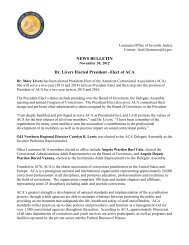Jan 1 Strategic Plan - Office of Juvenile Justice - Louisiana
Jan 1 Strategic Plan - Office of Juvenile Justice - Louisiana
Jan 1 Strategic Plan - Office of Juvenile Justice - Louisiana
You also want an ePaper? Increase the reach of your titles
YUMPU automatically turns print PDFs into web optimized ePapers that Google loves.
System ChallengesDepopulation <strong>of</strong> Swanson Center for YouthOJJ has successfully reduced the population at Bridge City Center for Youth and at Jetson Center for Youth inorder to implement the treatment model. This model requires not more than 12-14 youth in each housing unit.Swanson Center for Youth is beginning to come into alignment with the treatment model, however, the largenumber <strong>of</strong> youth make implementation challenging. OJJ is aggressively seeking methods to depopulateSwanson Center for Youth so that full implementation can occur.The staff regularly review the progress <strong>of</strong> youth in secure care to identify youth who may be able to be“stepped down” into a less restrictive appropriate environment, such as a community based group home. OJJstaff works with judges and district attorneys to explore and develop potential community options for theyouth.Additionally, in the upcoming year, OJJ will begin to see the benefits <strong>of</strong> statewide implementation <strong>of</strong> theSAVRY (Structured Assessment for Violence Risk in Youth) risk/needs instrument. This is an evidence basedtool to assess a youth’s risk in the community. The pr<strong>of</strong>essionals involved in determining a youth’s placementwill make decisions based on a validated instrument, encouraging the least restrictive appropriate placement.This may reduce the number <strong>of</strong> youth found to be in need <strong>of</strong> secure care.As noted earlier, OJJ is in the planning phase for the development <strong>of</strong> a secure facility in the Acadiana region.Simultaneously, the agency is investigating the feasibility <strong>of</strong> procuring two “moderate” secure facilities.“Moderate secure” is a level <strong>of</strong> care that is new to <strong>Louisiana</strong>. It provides for a less restrictive environment foryouth whose risk level is moderate or medium. The length <strong>of</strong> stay may be shorter and youth will have limitedaccess to the community. The focus is to eliminate behavior problems through treatment in the shortest timepossible and to transition youth into the community with a reasonable probability <strong>of</strong> success.Staff reviewing youth progress, the opening <strong>of</strong> the Acadiana facility, and the procurement <strong>of</strong> moderate securefacilities, work together to build a system leading to fewer youth being committed to secure care, allowing fora reduction in the number <strong>of</strong> youth placed in Swanson Center for Youth.Level <strong>of</strong> Violence in Secure Facilities70Safety within OJJ facilities is a top priority. As reform6050efforts have been implemented, altercations between youth40have shown decreases as well as increases at times. The chart3020shows the number <strong>of</strong> youth-on-youth altercations that have100taken place at secure care facilities since <strong>Jan</strong>uary 2008. OJJrecognizes that when youth first enter secure care, violence isBCCY JCY SCY<strong>of</strong>ten the only manner in which some youth know how toresolve issues. As youth receive treatment, OJJ expects the intensity and frequency <strong>of</strong> the violent behavior tosubside. OJJ has implemented a consistent and data driven process to measure the number <strong>of</strong> altercations thatoccur between youth. Staff can determine trends in time <strong>of</strong> day and locations <strong>of</strong> altercations. To ensure qualityassurance, staff examine treatment notes <strong>of</strong> youth who are considered “frequent fighters,” confirming thatyouth are counseled timely and that any issues that contributed to the youth’s anger/victimization are dealtwith appropriately. These combined interventions contribute to the safety <strong>of</strong> the youth and staff.Page 15Number <strong>of</strong> Altercations80Secure Care Altercations by Facility<strong>Jan</strong>uary 2008 - November 2009<strong>Jan</strong>-08Feb-08Mar-08Apr-08May-08Jun-08Jul-08Aug-08Sep-08Oct-08Nov-08Dec-08<strong>Jan</strong>-09Feb-09Mar-09Apr-09May-09Jun-09Jul-09Aug-09Sep-09Oct-09Nov-09
















